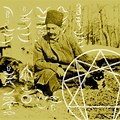



The Sanctity of Plants
People have always been spiritual, at least we can say so from looking at palaeolithic cave art and many images and objects people have created since that time, say 30,000 years ago. Indeed, spirituality has been the drive of much, if not most, culture and art through out time - think of the temples, sculpture and paintings. People used to believe so sincerely an afterlife that they made them sure their relatives were buried with goods they would need there, including sometimes a fortune in gold jewellery.
Today we may question the existence of an afterlife, and any jewellery goes in the will. Sometimes, we don't seem very spiritual at all . Yet, even we feel it strongly - there must be something else....
Where does this spirituality come from? put another way - what has made people think there is a life after death, and an intelligence that embraces the universe? Some sceptics would say that spirituality is just an ongoing tradition or superstition - that people don't have spiritual experiences, they just think they do.
These people can point to certain evidence. For example, the crystal in granite, being radioactive, cause brain stimulation including hallucinations, which may explain why it was used to build the neolithic dolmens (shelters) and to cover the walls of important rooms, like the King's chamber in Chepos pyramid in Egypt. People sat in these places and 'tripped out' - more or less like an acid trip (LSD).They thought they were having spiritual experiences, but may have been playing with their own minds.
The same sceptical attitude could be taken towards the spiritual use of sound, dance and plants. Sound, in the form of chanting, singing, or the repetition of mantras, sets up a vibration which changes the brain functioning and could cause a 'spaced out feeling'. Dance can do the same thing. Certain plants are psychoactive - they have an effect on the mind or psyche - and have been used by shamans for millennia, from South America to Siberia, to facilitate a state of trance, and another perception of reality. Some say these activities gave a false impression of 'spirituality' and fear and superstition did the rest.
This is a very one -sided point of view, for there are many other types of spiritual experience which involve neither stones, sound, dance nor plants. The basic spiritual experience is love, with some people falling in love after a very long time of knowing each other or instantly - seeing a stranger across a crowded room. When that loved-one is far away, they can be thought about, scanned for on the distant horizon, located and their spirit brought into the heart.
We seem connected in a way in a lay that defies the laws of place. Love is spiritual. Also nature is spiritual, with many people saying their strongest feeling of spirituality is when out amongst nature, on a mountain top perhaps, admiring the view, overcome with a strong sense of there being a beneficent intelligence watching over us all.
Many people have spontaneous spiritual experiences, when they suddenly 'get it' and become devout. Others have near-death experiences, see the other side, and come back certain of an after life. People hear voices - including some of the central characters in the Old Testament - when they're just walking along, not expecting revelation. And people have been bumping into angels for millennia.
It's because the spiritual realm is there that we have this thing called 'spirituality' . When people use stones , sound dance and plants, they are seeking to make the connection with something that they know is already there. These things are not the rason for spirituality, but a means to spirituality. People want to reconnect, and they feel they need help.
When Aaron burnt incense every morning and evening, it was not to create two little pockets of 'spiritual experience' within the day. Aaron felt they spirit all day long. He burned incense to concentrate his mind on the subject....and because God had told him to. Likewise, Buddists don't burn incense to receive the enlightment of Budda's words, they already know them, and believe them to be the right path to follow in life: incense is burnt to experience the enlightment directly, to connect with something they know is there.
Certain plants have been chosen as spiritual aids by people living thousands of miles apart, on different continents, in different millennia. Cedar is a case in point. The temple of Solomon in Jerusalem was built with cedars from Lebanon, and it is possible the Hebrews extracted an oil from the wood. In India, cedar is used to induce trance, while in Native American culture it is said to have the ability to counteract negative forces. Why should these, and other peoples choose cedar? Is it because it smells good: or because it does something in the spiritual realm: or because it does both?
Plant materials have long been used in spiritual practice, and the more fragrant they were, the more spiritual they were considered. This may be because fragrance transports. You can be in a place feeling very uncomfortable, with chaos and noise all around, then close your eyes, inhale a particular fragrance, and bypass it all, reconnecting with the great cosmic whole, and peace. It's like a private vehicle silently and instanteously whisking you away to reconnection: fragrance can be a ticket to the divine.
Reference: The Fragrant Heavens: V.A Worwood
Articles-Latest
- Koran burning conviction sparks fury as blasphemy law 'returns to UK'
- Robert Francis Prevost - Pope Leo XIV
- Pope Francis' death follows recent health challenges. Here's what we know about how he died.
- Easter April 2025 - international Celebrations
- The Rule of the twelve psalms -Worthy is the Lamb
- Religion in Africa Before Christianity and Islam
- 6 The Origin of Yahweh
- Dumo Di Milano
- What Did the Crow Tribe Believe In: Discover The Beliefs!
- 7 Reasons Historic Christianity Rejects the Book of Enoch
- 8 Breathtaking Mountain Monasteries Around the World
- Ethiopian Bible is oldest and most complete on earth
- Muhammad Muhammad was a prophet and founder of Islam.
- World Day of the Poor – SVP Christmas Campaign 2024
- Pope Francis to open 5 sacred portals on Christmas Eve — for a ritual that’s never been done before
- The 144,000 in Revelation
- Over 73 dead bodies 'used for meditation', 600 crocs in a pond, found in two Thai temples
- Occultism: Western Occult Tradition
- What is a Mudra
- Blood Sacrifices: Ancient Rituals of Life and Death
Articles-Most Read
- Home
- Let There Be Light
- Plants that feel and Speak
- The Singing Forest
- The Singing Forest-2
- Introduction
- Meditation
- Using Essential Oils for Spiritual Connection
- Heaven Scent
- Plants that Feel and Speak-2
- Purification
- Making the Spiritual Connection
- Anointing
- Essential Oils: The unseen Energies
- The Sanctity of Plants
- The Aroma Of Worship - Introduction
- The Aroma Of Worship-Foreward
- Methods Of Use
- Spiritual Blending
- Handling and Storage






